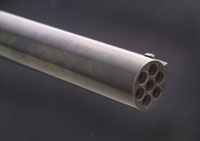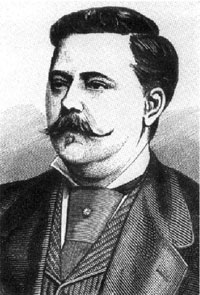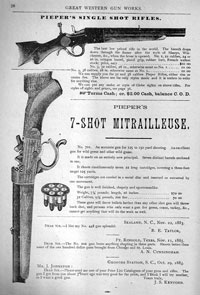

Sometimes it seems like I live my life in a small cardboard box in the middle of a swamp. There's just no other way to explain how I manage to miss things that are right under my nose. Things like the LaPorte County, Indiana, Historical Society Museum, for example.
I first heard of the LaPorte County Historical Society's William A. Jones Firearms Collection from my brother, who casually mentioned it during a conversation two years ago. Had I ever been there, he asked? Nope. Tell me more. And this is what he told me:
Back around the turn of the century, Laporte, Indiana, was a popular playground for Chicago's industrial elite. With its clean air, tranquil lakes and small-town charm, it's no wonder that LaPorte eventually attracted the attention of a fellow named William A. Jones, owner of a sizable iron foundry in the Windy City. When Jones visited LaPorte near the close of the nineteenth century, he fell in love with the place.
When he retired from the foundry business, William A. Jones was free to indulge his three passions: travel, firearms, and LaPorte, Indiana. First things first: he immediately built a mini-mansion on the shores of LaPorte's Pine Lake. Then he set off to search the world for rare and interesting guns, eventually amassing a collection of nearly a thousand of the coolest guns you've ever seen. When Jones died in 1921, he left his collection to the City of LaPorte, which in turn donated them to the Laporte County Historical Society.
Intrigued, I wasted no time in visiting the museum and found that my brother was right on the money. What a collection! I was so impressed that I photographed several of the museum's guns for the 16-page color section of the 17th edition of Standard Catalog of Firearms. Later, the museum invited me back to give tours of the Jones Collection.
During these tours people would frequently ask me, “What's the most interesting gun in the museum?” And I'd say, “That's simple. To me, it's the seven-shot Pieper Volley Gun.”
Never heard of the Pieper Volley Gun, have you? Neither had I until I stumbled across it in the LaPorte museum. If the LaPorte museum's W. A. Jones Collection of Antique Firearms contains the damndest stuff you've ever seen, then their Pieper Volley Gun has got to be the double-damndest.
Most of us know the name Pieper from the variety of inexpensive, single-shot Flobert rifles that Pieper and other Belgian gunsmiths churned out by the boatload. There's a tendency to dismiss these rifles, and all vintage Belgian arms, as junk, which they're not. After all, when John M. Browning was looking for someone to build his Auto-5 shotgun after Winchester gave it a thumbs-down, he chose Belgium's Fabrique Nationale.
And, more tellingly, American shooters embraced Pieper's little .22 Flobert rifles so enthusiastically that Winchester Repeating Arms felt compelled to go into the low-end .22 market with their Models 1900 and 1902 single-shots. If shooters back then didn't turn up their noses at Belgian guns, I'm not so sure we should do so now.
Were all turn-of-the-century Belgian guns top-quality? Certainly not. Neither were all American guns. My point here is that it's dangerous to dismiss an entire class of firearms unilaterally, because sooner or later (usually sooner) an exception will pop up and prove you wrong. The Pieper Volley Gun is just such an exception.
Henri Pieper was born in the German town of Soest in the Westphalia region on October 30, 1840. After receiving some basic training in machining and a stint at a woolen mill, he apprenticed with a gunsmith named Warstein. A telented metalworker with an interest in firearms, Pieper emigrated to Belgium in 1859 and subsequently mastered his craft in Herstal, Verviers and Liege.
Around 1866 Pieper opened his own firearms factory at #12 Bayard Street in Liege; he made rifle barrels. Apparently business was booming, for by 1870 his shop had grown to occupy 6,000 square meters. That same year he partnered with a barrelmaker named Nessonvaux in the Vesdre valley.

Henri Pieper seems to have a pretty good head for business. In 1887, he joined a conglomerate of high-profile Belgian arms makers including Jules Ancion, the Dumoulin brothers, Joseph Janssen, Pirlot-Frésart, Draws up-Laloux & Co., Albert Simonis and Emile and Leon Nagant. (Of these, American shooters are probably most familiar with the shotguns, cape guns and double rifles of Dumoulin and the famous Nagant gas-seal revolvers, which were probably designed by Pieper.) Along the way, Piper found also manufactured bicycles and one of the earliest automobiles, the so-called Pieper “Bicyclette.” As if that weren't enough, Pieper also found time in his schedule to act as one of the co-founders of Fabrique Nationale, the largest armsmaker the world has ever seen.
Most Pieper firearms are stamped with the “ELG” proofmark that indicates Belgian origin, and often with other proofs as well. In addition, Pieper marketed firearms not only under his own name but under the following trademarks: Bayard; Eagle Gun Works; E.Leroy; Modified Diana; Diane; The Leader; Bayard Arms Company; Pieper Arms Company; Premier Arms Company; Damascus Compound; National Arms Company; Henry Arms Company; Royal Gun Works; Le Rationnel (sometimes seen as “The Rational”); Pieper Top Bolt; Schutz Marke; E-K; Eclipse Company; Metropole; Pieper's Compressed Steel; Monarch Arms Company; and probably many other trade names as well.
Although Henri Pieper held 69 Belgian patents, much of his firearms production was based on existing designs such as the Flobert rifle, the Warnant rifle, the Remington Rolling Block Rifle, and the Nagant revolver. I have also seen copies of the Stevens single-shot Lord pistol that bore the Pieper name, and it seems fair to say that Pieper was primarily a firearms maker and only secondarily a designer. After an all-too-brief lifetime of churning out hundreds of thousands of sporting arms and military weapons, he died (probably from overwork) on August 23, 1898, at only 57 years of age.
The Pieper company was subsequently reorganized as “Etablissements Pieper” and continued for a time under the direction of Pieper's son Nicolas. The strain of diversification, particularly in the area of automobiles, brought the company to its knees, and in 1905 the board of directors invited Nicolas Pieper to take his hat and go. The company was once again reorganized, this time as “Les Anciens Etablissements Pieper,” and moved to an entirely new factory in Herstal in 1907.
The thrice-born company concentrated solely on the manufacture of weapons and sporting arms; it's estimated that at its peak, Les Anciens Etablissements Pieper was turning out 60,000 shotguns, 30,000 automatic pistols, 30,000 rifles and 12 million cartridges a year! This may explain why we find so many Pieper guns floating around. Les Anciens Etablissements Pieper actually survived both world wars — no mean feat when you're headquartered in Belgium — and continued making arms of nearly every description before winking out for good in 1956.
The Pieper Volley Gun that resides in the Laporte County Historical Museum (www.laportecountyhistory.org) is an odd duck indeed. It is based on the Remington Rolling Block Action, which was one of the simplest, strongest single-shot actions of the late 1800s and one that successfully bridged the blackpowder and smokeless eras.

If you ever get the chance to see the 1960 movie The Alamo starring John Wayne as Davy Crockett and Richard Widmark as Jim Bowie, take a good look at what Richard Widmark is dragging around. It's a volley gun. To be specific, it's a Hollywood replica of the Nock Volley Gun, a seven-barrel .52-caliber flintlock boomer that fired all seven barrels simultaneously when the trigger was pulled.
The original Nock Volley Gun was built in 1779 for the Royal Navy. It was used to shred the sails of enemy ships at close range and to clear their decks by firing it, more or less indiscriminately, into the ranks of enemy sailors. I can't imagine what it must have been like to shoulder-fire seven 52-caliber barrels all at the same time, but it couldn't be an experience I'd care to repeat. Wow.
Actually, most of us have probably already seen a volley gun of sorts in person. Remember the old three-barreled percussion “Duck's Foot” pistol that was offered in magazine ads in the '70s and '80s? The Duck's Foot was a volley gun. It fired three .36-caliber balls all at once from three separate barrels arranged more or less in the shape of a duck's foot.
The pistol was usually offered in kit form and still shows up in the Dixie Gun Works catalog from time to time. The original eighteenth-century Duck's Foot pistol was intended for use aboard ships, where a captain might need to keep a murderous mob of mutineers at bay.
Naval warfare wasn't what Henri Pieper had in mind when he built his volley gun. More likely he intended it as a market gun. Back before 1918, there were no bag limits on waterfowl, and many hunters made their living by shooting as many ducks as they could in a single day and taking them down to the local meat market to sell. Most market hunters used plain old everyday shotguns, but hardcore market hunters used punt guns or volley guns.
A punt gun, of course, was an enormous smoothbore with a caliber frequently larger, sometimes much larger, than one inch. It was loaded with as much as a half-pound of shot and lashed to the gunwale of a punt, a small skiff-like boat. You'd paddle or pole the punt gun toward the birds, point the front of the boat at them, then — Ka-blooey! Afterward, you'd pick up the dead birds with a long-handled net and bundle them off to market. (The LaPorte County Museum also has two punt guns in its collection.)
The Pieper Volley Gun must have served the same purpose. It has seven rifled .32-caliber barrels, all of which fire at once. There's a single pair of sights on top of its barrel cluster, which meant you couldn't do much precision shooting with it. When you saw a bunch of geese or ducks on the water, you simply aimed at the unlucky one in the middle and squeezed ‘er off. You were bound to bag two or three birds at the least.
All of this sounds terribly shabby to us today, but the market hunter of the past never claimed to be a sportsman. He was a meat hunter, pure and simple, and if a punt gun or volley gun helped him put a roof over his head and bread on the table, he'd use one if he could afford it. But market hunters nearly wiped out several species of waterfowl, and the Migratory Bird Treaty Act of 1918 put an end to the practice forever.

In a rare print reference, the Pieper Volley Gun was advertised in the 1888 – 1889 Great Western Gun Works Catalog as “Pieper's 7-Shot Mitrailleuse,” “mitrailleuse” being an old French word for a multi-barreled firearm. It was said to be “an accurate gun for 125 to 150 yard shooting” and “an excellent gun for wild geese and other wild game.” The catalog boasted that the Pieper gun, which was available in .22 or .32 rimfire, “will throw bullets farther than any other shot gun will throw buck shot, and persons who only want a gun for geese, crane, turkey, etc., cannot get anything that will do the work as well.”
Further, the Pieper Mitrailleuse was said to have a spread of three feet at 125 yards, so it was admirably comprehensive. The gun retailed for an astounding $70, whereas you could order a Winchester Model 1886 Express Rifle in .50-95 for “only” $20.25. That makes the Pieper Volley Gun one of the most expensive guns of its day.
I didn't have an opportunity to shoot the LaPorte Museum's Pieper Volley Gun, of course, as museums tend to frown on that sort of thing. But I was permitted to handle it and examine it rather closely.
As near as I can tell, to fire the Pieper Volley Gun you opened the action by thumbing back the hammer and operating the action lever, which also serves as a trigger guard. (This is different from the action of the Remington Rolling Block rifle, on which the breechblock is retracted by a thumbpiece.) You'd then remove the disc-like cartridge carrier, insert seven cartridges into its chambers, put the whole thing back into the chamber and close the action lever to bring the breech into battery. You could then put the gun on half-cock or just squeeze the trigger.
Then — blammo! Seven at a single blow, just like the Brave Little Tailor.
To extract the fired shells, you had to open the action and remove the entire carrier, which is a separate piece fitted tightly to the barrel group. I guess you then had to poke out the empties with a stick or something.
I had supposed the Pieper Volley Gun in the LaPorte collection was a very rare piece, but it turns out that a similar Pieper Volley gun was recently offered by C. W. Slagle Antiques of Phoenix, Arizona. The Slage gun was chambered in .22 rimfire (known in Europe as the 6mm Flobert) and shows sign of use. The one in the LaPorte museum, however, looks as though it just left the factory. It's in virtually new condition and doesn't appear ever to have been fired.
As so often happens when I get to researching a particular firearm, now I want a volley gun. I wouldn't ever use it on waterfowl, of course, but for those 150-yard shots on turkey it'd be just the thing.

Next Step: Get your FREE Printable Target Pack
Enhance your shooting precision with our 62 MOA Targets, perfect for rifles and handguns. Crafted in collaboration with Storm Tactical for accuracy and versatility.
Subscribe to the Gun Digest email newsletter and get your downloadable target pack sent straight to your inbox. Stay updated with the latest firearms info in the industry.

![Best Concealed Carry Guns In 2025 [Field Tested] Wilson Combat EDC X9S 1](https://gundigest.com/wp-content/uploads/Wilson-Combat-EDC-X9S-1-324x160.jpg)


![Best 9mm Carbine: Affordable PCCs [Tested] Ruger Carbine Shooting](https://gundigest.com/wp-content/uploads/Ruger-Carbine-Shooting-100x70.jpg)

